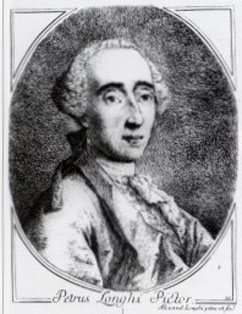| Pietro Longhi  AKA Pietro Falca AKA Pietro Falca
Born: 1702
Birthplace: Venice, Italy
Died: 8-May-1785
Location of death: Venice, Italy
Cause of death: unspecified
Gender: Male
Religion: Roman Catholic
Race or Ethnicity: White
Occupation: Painter Nationality: Italy
Executive summary: 18th century Venetian painter Venetian painter, born in Venice. He was a pupil of Antonio Palestra and Giuseppe Maria Crespi at Bologna, and devoted himself to the painting of the elegance of the social life in 18th century Venice. The republic was dying fast, but her sons, even in this period of political decline, retained their love of pageants and ceremonies and of extravagant splendor in attire. The art of Venice was vanishing like her political power; and the only painters who attempted to stem the tide of artistic decadence were the Canaletti, Guardi, Tiepolo and Longhi. But while the Canaletti and Guardi dwelt upon the architectural glories of Venice, and Tiepolo applied himself to decorative schemes in which he continued the tradition of Paolo Veronese and Tintoretto, Longhi became the chronicler of the life of his compatriots. In a way his art may be set beside William Hogarth's, though the Venetian did not play the part of a satirical moralist. He has aptly been called the Goldoni of painting. His sphere is that of light social comedy -- the life at the café, the hairdresser's, at the dancing school, at the dressmaker's. The tragic, or even the serious, note is hardly sounded in his work, which, in its color, is generally distinguished by a rich mellow quality of tone. Most of his paintings are in the public and private collections of Venice. They are generally on a small scale, but the staircase of the Palazzo Grassi in Venice is decorated by him with seven frescoes, representing scenes of fashionable life. At the Venice academy are a number of his genre pictures and a portrait of the architect Temanza; at the Palazzo Quirini-Stampalia the portrait of Daniele Dolfino, "The Seven Sacraments" (etched by Pitteri), a "Temptation of St. Anthony", a "Circus", a "Gambling Scene", and several other genre pictures and portraits; at the Museo Correr a dozen scenes of Venetian life and a portrait of Goldoni. In England the National Gallery owns "The Exhibition of a Rhinoceros in an Arena", a "Domestic Group", "The Fortune-Teller", and the portrait of the Chevalier Andrea Tron; two genre pictures are at Hampton Court Palace, and others in the Richter and Mond collections. Many of his works have been engraved by Alessandro Longhi, Bartolozzi, Cattini, Faldoni and others. Longhi died in Venice in 1762.
Do you know something we don't?
Submit a correction or make a comment about this profile
Copyright ©2019 Soylent Communications
|